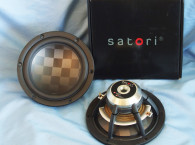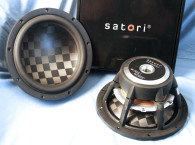Following the acquisition, Voice Coil hadn’t featured any of the new products from Eighteen Sound until our April 2021 issue, so it’s great to welcome them back! This time Eighteen Sound sent one of its latest 1.4” compression driver designs, the NSD1424BTN, that I combined with the Eighteen Sound XT1464 elliptical-shaped horn from my horn inventory for testing (Photo 1).

Designed for use with 1.4” throat horns, the ultra-compact Eighteen Sound NSD1424BTN compression driver has a 1.4” (35.6mm) throat diameter driven by a 62mm (2.4”) diameter edge-wound voice coil wound with aluminum wire on a non-conducting Nomex former with a proprietary treatment. This specially treated Nomex former shows a 30% higher value of tensile elongation at operating temperatures (200°C) when compared to Kapton.
This assembly drives the proprietary True Pistonic Motion (TPM) Tin (nitrate compound)-coated titanium diaphragm, which doubles the stiffness compared to non-coated titanium diaphragms. The NSD1424BTN also incorporates a proprietary phase plug design (3P) that has short openings and a high flare rate that, according to the company, reduces distortion and improves mid-range detail.
Other features include a computer-optimized neodymium multiple magnet motor structure, a copper pole piece shorting ring (Faraday shield), a continuous power handling of 140W with a 70W nominal power handling rating, a 1.2kHz recommended crossover frequency (with a minimum 12dB/octave high-pass network), corrosion resistant coating on the magnets and plates, a black emissive coating on an array of heatsink fins on the O ring sealed rear cover, a 2.83V/1m 110dB sensitivity, plus color-coded push terminals.
Along with the NSD1424BTN, I used the Eighteen Sound 1.4” XT1464 60° x 50° elliptical constant directivity horn with a 500Hz cut-off frequency. FEA-computer designed and made from high pressure die cast polyurethane foam, the XT1464 has a smooth flare rate that provides a low distortion spherical wavefront and constant directivity from 1.5kHz. This horn has been featured in previous Voice Coil explications, so I will dispense with the vertical off-axis and polar plots; however the horizontal and vertical contour spectrogram color plots are shown.
I commenced testing using the LinearX LMS analyzer to produce the 300-point stepped sine wave impedance plot shown in Figure 1, with the solid black curve representing the NSD1424BTN mounted on the XT1464 horn and the dashed blue curve representing the compression driver without the horn. With nominal 16Ω impedance, the ND1424BTN has an 8.97Ω DCR, with minimum impedance mounted on the XT1464 horn of 6.70Ω and at 6.80kHz.
For the first set of SPL measurements, I free-air mounted the NSD1424BTN/XT1464 combination without an enclosure and measured both the horizontal on- and off-axis at 2.0V/0.5m (normalized to 2.83V/1m), from 0° on-axis to 60° off-axis using the LoudSoft FINE R+D analyzer and the GRAS 46BE microphone (supplied courtesy of LoudSoft and GRAS Sound & Vibration, respectively). Figure 2 displays the on-axis frequency response of the compression driver/horn, which has a relatively smooth ±2dB response up to 10kHz (assuming the constant directivity roll-off equalized) with no major anomalies below 17kHz. Figure 3 shows the 0° to 60° on- and off-axis response in the horizontal plane. Figure 4 displays the normalized horizontal plane response. Figure 5 shows the 180° horizontal polar plot (in 10° increments with 1/3 octave smoothing applied) that was generated by the CLIO Pocket analyzer and the accompanying microphone (courtesy of Audiomatica SRL).
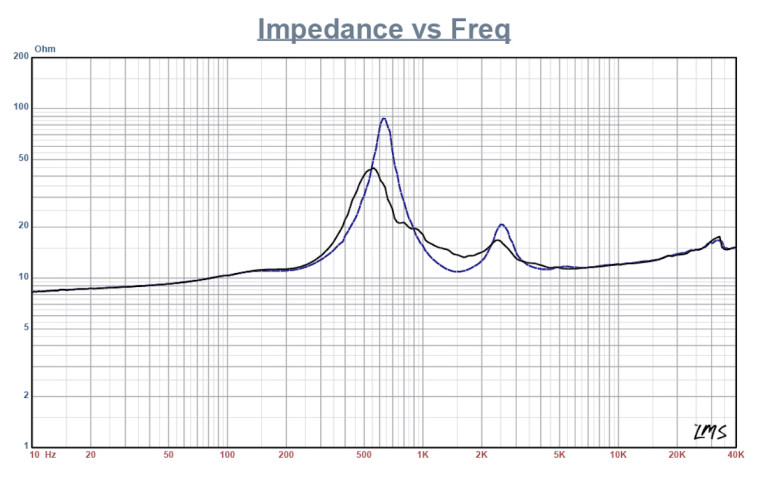

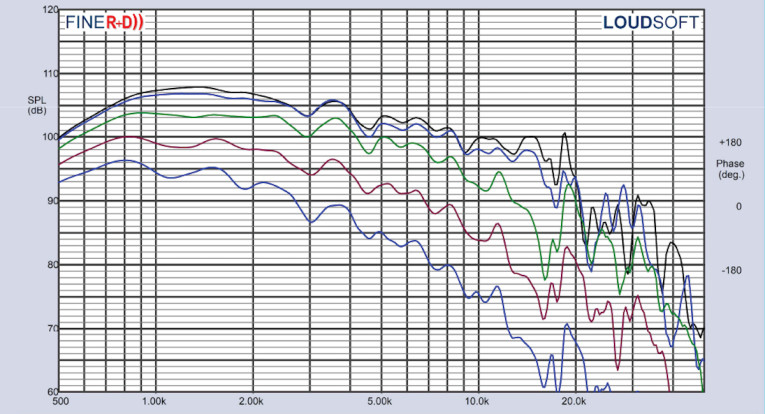


As I mentioned, since this Eighteen Sound horn has been previously featured, I am dispensing with the vertical axis measurements, since that is mostly horn related. However, the horizontal and vertical axis contour (directivity spectrogram) for the XT1464 elliptical flare horn is given in Figure 6 and Figure 7, respectively. Last, Figure 8 gives the two-sample SPL comparison showing the two Eighteen Sound NSD1424BTN compression driver samples to be closely matched within 1dB or less throughout the drivers operating range except for a small area at 9kHz.
For the remaining series of tests, I set up the Listen, Inc. AudioConnect analyzer and 1/4” SCM microphone (provided to Voice Coil courtesy of Listen, Inc.) to measure distortion and generate time-frequency plots. For the distortion measurement, I mounted the NSD1424TBN/XT1464 combination in free-air in the same manner as was used for the frequency response measurements.
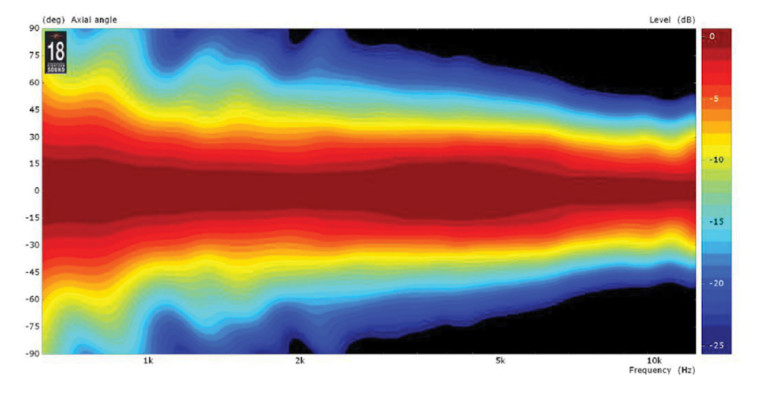
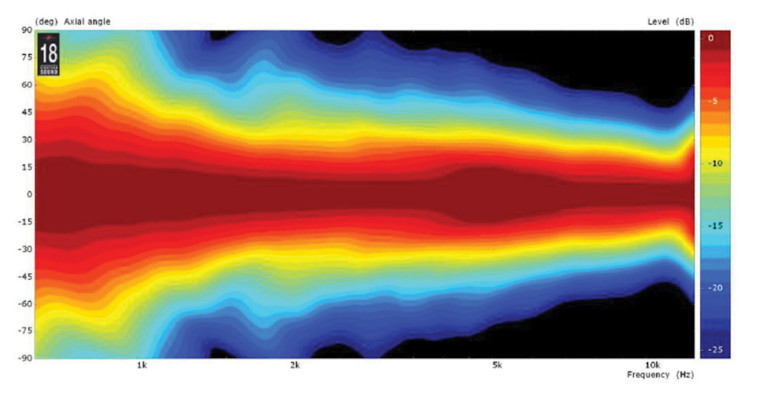

Next, I set the SPL to 104dB at 1m (2.23V), determined by using a pink noise stimulus generator and internal SLM in the SoundCheck 18 software. I then measured the distortion with the Listen microphone placed 10cm from the mouth of the horn. This produced the distortion curves shown in Figure 9, exhibiting very low third harmonic content.

Following this test sequence, I set up SoundCheck 18 to generate a 2.83V/1m impulse response curve for this driver/horn and imported the data into Listen’s SoundMap Time/Frequency software. Figure 10 shows the resulting cumulative spectral decay (CSD) waterfall plot. Figure 11 shows the Short Time Fourier Transform (STFT) plot.
Considering all the objective measurement data, the Eighteen Sound NSD1424BTN compression driver is obviously a well-engineered 1.4” compression driver, exhibiting good performance, great build quality, and featuring a number of proprietary enhancements—all typical of a seasoned pro sound OEM such as Eighteen Sound. For more information, visit www.eighteensound.com. VC
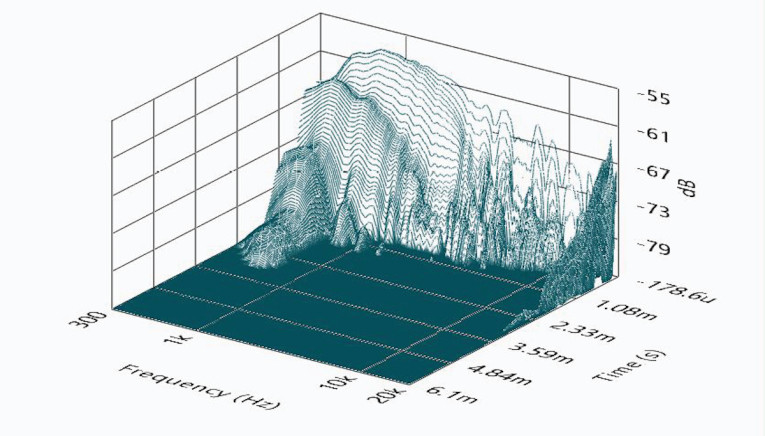

This article was originally published in Voice Coil, May 2021.




